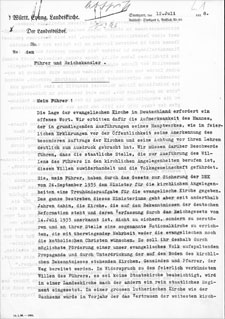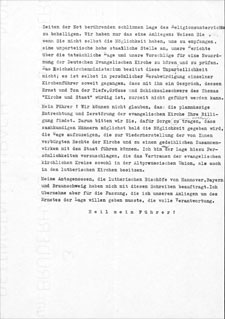Letters of Protest to Hitler
From 1935 to 1939, Wurm strove to preserve the regional church’s autonomy and simultaneously to be loyal to the Nazi state. Thus, unlike part of the Confessing Church, he was willing to work together conditionally with the Reich Ministry of Church Affairs created by Hitler in 1935 and its head Hanns Kerrl; he accepted the Confessing Church’s split into a Lutheran and a radical “Dahlemite” wing.
Even from pastors of his regional church, Wurm consequently had to endure the accusation of being too accommodating to the state in order to secure the church’s continued existence as a corporation; theological issues receded in the background for him, according to his critics.
Wurm zealously defended church rights against assault in the wake of the “de-confessionalization of public life” propagated by the National Socialists in 1935. Time and again, he confronted the Nazi state with the law. Various disputes revealed that the judiciary was still independent.
In the dispute over denominational schools, the Württemberg regional church initially strove to prevent the introduction of non-denominational schools being pursued by the minister of education. When, however, the ministry assured that religion class would be taught as it had been, the regional church capitulated in April of 1936.
Wurm sought to influence the regime’s increasingly anti-church course, which was linked especially with the names of Bormann, Rosenberg and Himmler, in various ways to secure toleration of the church’s work. Wurm’s intention in talks with functionaries was to consolidate and secure the church’s position.
He even approached Hitler himself. On behalf of other church leaders as well, Wurm protested on July 12, 1938 in a fundamental letter against the establishment of finance departments, which were intended to give the state direct influence on the Protestant churches. According to Wurm, this – just as a number of other measures – would imperil the “national community” and destroy the churches; it contravened the rights of the churches promised by the Nazi state.
Unlike the Confessing Church’s memorandum produced in May of 1936, Wurm’s letter clearly did fundamentally challenge Nazi weltanschauung. Instead, it was primarily aimed at winning over Hitler to intervene for the benefit of the churches. Wurm’s intention was to exert influence on Nazi church policy and to protect the church’s status so that it could continue working among the people.
Source / title
- © Landeskirchliches Archiv Stuttgart, D1/77



